Dead or Alive Dimensions Review
|
|
See PixlBit's Review Policies

On 06/20/2011 at 03:44 PM by Matt McLennan , Nick DiMola Can DoA’s first Nintendo entry appeal to both a DoA newbie and a DoA regular? |

A great entry point for people new to the DoA series, but some issues might put long time DoA fans off.
For those wishing to see a review done by someone who has played the rest of the DoA series, please see Nick’s review of the game.

I am not what you’d call a big fan of fighting games, except for the Super Smash Bros. series and Soul Caliber 2. While I did get Super Street Fighter IV 3D Edition with the 3DS, Street Fighter was always a series that never really appealed to me. Despite enjoying some of the Capcom Versus games, 2-D fighters have always been hit or miss with me; however, 3-D fighters like Soul Calibur 2 ate up a lot of my time. I didn’t, however, get into the Dead or Alive series since I never owned any of the systems the mainline fighting games appeared on.
That isn’t to say I haven’t played a DoA game prior to Dimensions. I have played a bit of DoA 4, but I couldn’t understand its often-praised counter system. Sadly, I stopped playing it, though I did appreciate the finely crafted graphics (including the hilarious boob physics). With the 3DS, Nintendo finally got a DoA game from Team Ninja, and for someone who is both a fan of Nintendo handhelds and 3D fighting games, this seems like it should go together like peanut butter and jam. Short answer: It did. However, there were a few bumps along the way.
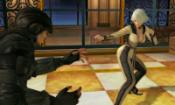
First things first, the game looks amazing. Without the 3D effect, the game runs at a smooth 60 frames per second. The entire character roster are animated wonderfully, including the hilarious boob physics the series is (in)famous for. With the 3D on, the environments gain more depth, but during battles the game’s frame-rate dips somewhat to around 30-40 frames per second. Is it a game killer? Absolutely not. The game still looks wonderful.
Does it sound as wonderful though? Music and sound effects sound crisp and clear, with individual characters getting their own theme music. The Japanese voice track sounds very nice, giving the characters each a distinct personality, especially in DoA Dimensions main story mode. On the negative side, the English voice acting leaves a lot to be desired. While there are some well-known voice actors present (Wendee Lee as Ayane), their performances are awkward at best.
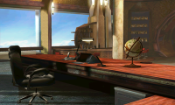
So the game looks great and sounds great (for the most part), but now it’s time to switch things around and dive head first into the game play. Dimensions does things about 80% right. How does that work exactly? The perfect part is how the game controls. Button presses are responsive and moving with the slide pad is super smooth. Touch screen controls are completely optional, since the move list slides to whatever combo you try to input as soon as you press a button making it tough to use. This makes touch screen only use a non-option since the move list slides around so much with normal button presses.
The main story mode - called “Chronicle” - spans five chapters and serves as both a refresher to the DoA storyline and a tutorial for people new to the DoA series. The tutorial for the game does a great job explaining and showing how the fighting system works; everything from performing combos, counters and holds are done in a well-designed fashion, making sure you get it right without holding your hand too much. The cutscenes sprinkled between these fights, however, are hit and miss. Half of the cutscenes are fully animated, while the other half seem to be influenced by Bayonetta’s non-animated cutscenes. Whereas Bayonetta’s cutscenes were given the photo-reel aesthetic, Dimensions’ non-animated cutscenes look like emoted dolls going through a story scene.
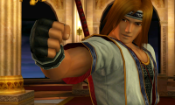
And the storyline, which covers DoA’s “epic” saga isn’t overly special. All five chapters are ninja centric, meaning you only play as Kasumi, Hayate/Ein, Ayane, or Ryu Hayabusa, with Helena being the only non-ninja character. Aside from some story parts with Kasumi and Ayane being the most interesting, the overall storyline is quite dull. Thankfully you are given the option to skip cutscenes from the get-go.
Other modes included in the game are Arcade, Survival, Training, Free Play, Tag, Throwdown, and Local/Internet match up. Arcade mode only has six stages with pre-determined characters, and can be plowed through fairly quickly. Tag, Survival, Free Play and Training are pretty self-explanatory as to what they do. Tag mode, however, should be played with two people via local wireless; more often than not, the A.I. controlled character doesn’t exactly do their jobs, and when you are facing off with just one opponent, their defense is doubled.
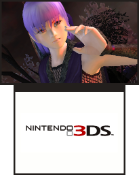
The real stars of the game modes are Throwdown and the Local/Internet match up modes. Throwdown, using the 3DS StreetPass feature, allows 3DS systems with Dimensions’ StreetPass activated to transmit throwdown challenges to each other. The respective 3DS owners will then face off against an A.I. controlled opponent based off of which character the owner uses the most and how they fight with it. Sadly, I have not encountered a throwdown via StreetPass, but Team Ninja has provided a Throwdown challenge over SpotPass, and whether you win or lose, you will receive a gift.
And receive you will. Fighting through any of the game’s modes will unlock figurines, fighters and outfits depending on certain conditions. Already, Tecmo Koei and Team Ninja took advantage of SpotPass by sending out free DLC in the form of costumes. Also, from the main menu, you can spend ten 3DS play coins to unlock extra content, which randomly varies. Included with the figurines is the option to take pictures of them, because we all know you want to take close up photos of Lisa’s bust.
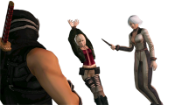
Internet battles are, without a doubt, the best feature within this game. Three options are given: friends, local and world. After choosing your option, you are presented with the choice of what type of winning system: any, two K.O. or three K.O., with the second option being the most common one I have experienced. In the battles I have experienced, there was hardly any slowdown, and it went quite smoothly (though I haven’t won many battles. I still stand at an F+ ranking).
Fighting games seem to be to the 3DS what JRPGs were to the DS; with the slide pad, portable fighting games seem to be getting their time to shine. While Capcom has had earlier success with Super Street Fighter IV 3D, Team Ninja may take that success even further with Dead or Alive: Dimensions' more user-friendly approach.
Nick's Review
Being that Matt is in charge of the general review details, I’ll keep my section of the review limited to the gameplay and the overall experience. While Matt is a newcomer to the Dead or Alive series, I’ve been able to play each title in the series (minus the Beach Volleyball junk). That being said, it’s pretty clear that Dimensions is the best of the bunch.
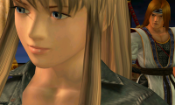
For starters, it features the largest roster in a DoA game to date, which is exactly what is expected in a title meant to recap the entire story and series up till now. The fighting mechanics have been fine-tuned here, and even better, the game makes an exerted attempt to explain these various mechanics to the user throughout the Chronicles mode. Furthermore, the combos are always displayed on the bottom screen, and while they are mostly unreadable and completely unusable as touch controls, they often can be caught in your peripheral vision because they are always changing to suit the current situation. This means that even if you can’t get the full picture of the available controls, the game does prompt you when you can do different things.
With a greater understanding of the different techniques, players are left only to perfect their skills, particularly advanced countering and effective blocking. In this regard, the game provides a nice opportunity for amateur players to enter a skill tier that they may not have competed at ever before in a fighting game. Coupled with an online mode and plenty of single player modes, players have a nice variety of places to test their mettle.

For those experienced with the series that have already had their fill, it’s not different enough to warrant much excitement. The roster was plenty big in DoA 4 and the experience is so similar that unless you want a DoA to go, it’s an entry that can be skipped. The tag match ability is probably the biggest addition and it works clunky at best. With the tagged character being computer controlled, it rarely proves to be a desirable way to play the game.
Though I enjoyed the Dimensions experience, I did encounter a few concerning inconsistencies. First off, the game requires players to complete the entire Chronicles mode to unlock some of the special characters. The Arcade mode will unlock the basics, but the Chronicles mode is a requirement to unlock things in the Tag match mode. Veterans not interested by the story will be bored to tears by the painfully easy Chronicles mode. As such, I avoided completion of this mode and went on to beat a couple of the harder Tag match challenges. Unfortunately this didn’t unlock the characters that they were supposed to, nor were they unlocked after completing the Chronicles mode, which I found out was a prerequisite. As such, I was forced to complete those extremely tough tag challenges again to get those special characters. This was frustrating to say the least.
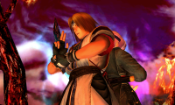
The frame rate also seems to be a little iffy, particularly when the 3D is on. Maybe it’s my mind playing tricks on me, but I found the game to play far smoother without the 3D. Things only got worse when I took the game online. The frame rate dropped to inconsistent, unplayable levels for me during the few matches I tried out.
Other than these minor issues, Dimensions is a stand out experience that bolsters the 3DS fighting library, providing a game that amateurs can truly enjoy from the get-go - something that's tougher to say for Super Street Fighter IV 3D, which features much deeper complexity and stiffer fighting mechanics.







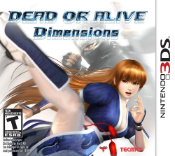

Comments